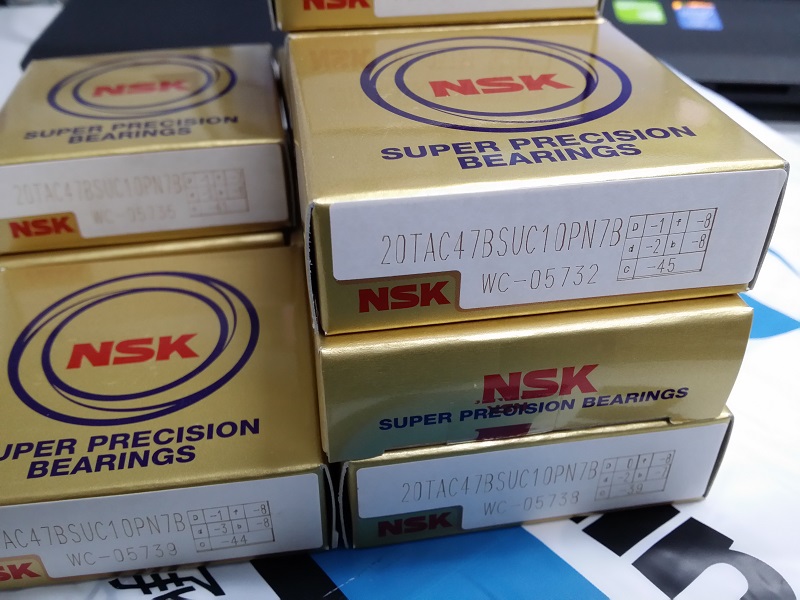Bearings have many failures, and many users who use bearings have experienced this. After the bearing has been running for a period of time, it is necessary to check whether there is any problem, and pay special attention to whether the bearing fails. The main reasons for failure are as follows:
1. Contact fatigue failure
Contact fatigue failure refers to the failure of the NSK imported bearing working surface subjected to alternating stress. Contact fatigue spalling occurs on the working surface of the bearing and is usually accompanied by fatigue cracks. It first occurs from the maximum alternating shear stress below the contact surface, and then expands to the surface to form different spalling shapes, such as pitting or pitting spalling. Peeling into small flakes is called shallow peeling. Because of the gradual expansion of the exfoliation surface, it often expands to the deep layer, forming deep exfoliation. Deep spalling is a source of fatigue for contact fatigue failure.
2. Wear failure
Wear failure refers to the failure caused by the continuous wear of the metal on the working surface due to the relative sliding friction between the surfaces. Continued wear and tear will cause gradual damage to NSK imported bearing parts, and eventually cause loss of bearing dimensional accuracy and other related problems. Wear may affect the shape change, the increase of the fit gap and the change of the working surface shape, which may affect the lubricant or make it contaminate to a certain degree, resulting in the complete loss of lubrication function, and thus the bearing loss of rotation accuracy or even normal operation. Wear failure is one of the common failure modes of various types of bearings. According to the form of wear, it can be divided into the most common abrasive wear and adhesive wear.
Abrasive wear refers to the wear caused by foreign hard particles or hard foreign matter or metal surface wear debris between the working surfaces of the bearing and the relative movement of the contact surfaces. It often causes furrow-like damage on the working surface of the bearing. Hard particles or foreign matter may come from the inside of the main engine or from other adjacent parts of the main engine system and are fed into the bearing by the lubricating medium. Adhesive wear refers to the uneven force on the friction surface due to fine protrusions or foreign objects on the friction surface. When the lubrication conditions are severely deteriorated, the local friction generates heat, which can easily cause local deformation of the friction surface and small friction welding. In severe cases, the surface The metal may melt locally, and the force on the contact surface tears the local friction welded joints from the substrate and increases the plastic deformation. This adhesion-tear-adhesion cycle process constitutes adhesive wear. Generally speaking, slight adhesive wear is called abrasion, and severe adhesive wear is called bite.
3. Fracture failure
The main reasons for the failure of NSK imported bearings are defects and overload. When the external load exceeds the strength limit of the material and the part breaks, it is called overload fracture. The main cause of overload is the sudden failure of the host or improper installation. Defects such as microcracks, shrinkage cavities, bubbles, large foreign objects, overheated tissues, and local burns of bearing parts can also cause fracture at the defect during impact overload or severe vibration, which is called defect fracture. It should be noted that in the manufacturing process of the bearing, the re-inspection of raw materials, the quality control of forging and heat treatment, and the control of the processing process can be used to correctly analyze whether the above-mentioned defects exist or not, and the control must be strengthened in the future. But generally speaking, most of the bearing fracture failures that generally occur are overload failures.
Click here for more details about NSK 20TAC47BSUC10PN7B.

4. Failure of clearance changes
In the work of NSK imported bearings, due to the influence of external or internal reasons, the original fit clearance is changed, the accuracy is reduced, and even the "seizure" is called the clearance change failure. External reasons such as excessive interference, improper installation, expansion caused by temperature rise, instantaneous overload, etc., internal reasons such as residual austenite and residual stress in an unstable state are the main reasons for the failure of clearance changes.
1) When using and installing, it is necessary to be careful not to allow strong stamping. The solution to the problem of the motor bearing is not allowed to directly hit the bearing with a hammer, and it is not allowed to transmit pressure through the rolling elements.
2) Use appropriate and accurate installation tools as much as possible to use special tools, and try to avoid the use of cloth and short fibers.
3) Try to keep NSK imported bearings and their surrounding environment clean. Motor bearings generally use sodium-based grease. Even if the invisible smile dust enters the bearing, it will increase the wear, vibration and noise of the bearing.
4) Prevent the rust of NSK imported bearings. When directly picking up the bearings by hand, wash away the sweat from your hands and apply high-quality mineral oil before proceeding. Pay special attention to rust prevention during the rainy season and summer. Under certain special operating conditions, the bearing can obtain a longer life than traditional calculations, especially under light load conditions. Analysis of the mechanism and influencing factors of the bearing housing labyrinth seal. These special operating conditions are that when the rolling surfaces (tracks and rolling parts) are effectively separated by a lubricating oil film and limit the surface damage that may be caused by contaminants.

 News
News